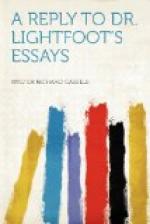In examining this evidence, we proceeded upon clear and definite principles. Without forming or adopting any theory whatever as to the date or origin of our Gospels, we simply searched the writings of the Fathers, during a century and a half after the events in question, for information regarding the composition and character of these works and even for any certain traces of their use, although, if discovered, these could prove little beyond the mere existence of the Gospels used at the date of the writer. In the latter and minor investigation, we were guided by canons of criticism, previously laid down, which are based upon the simplest laws of evidence. We found that the writings of the Fathers, during a century and a half after the death of Jesus, are a complete blank so far as any evidence regarding the composition and character of our Gospels is concerned, unless we except the tradition preserved by Papias, after the middle of the second century, the details of which fully justify the conclusion that our first and second Synoptics, in their present form, cannot be the works said to have been composed by Matthew and Mark. There is thus no evidence whatever directly connecting any of the canonical Gospels with the writers to whom they are popularly attributed, and later tradition, of little or no value in itself, is separated by a long interval of profound silence from the epoch at which they are supposed to have been composed. With one exception, moreover, we found that, during the same century and a half, there is no certain and unmistakable trace even of the anonymous use of any of our Gospels in the early Church. This fact, of course, does not justify the conclusion that none of these Gospels was actually in existence during any part of that time, nor have we anywhere suggested such an inference, but strict examination of the evidence shows that there is no positive proof that they were. The exception to which we refer is Marcion’s Gospel, which was, we think, based upon our third Synoptic, and consequently must be accepted as evidence of the existence of that work. Marcion, however, does not give the slightest information as to the authorship of the Gospel, and his charges against it of adulteration cannot be considered very favourable testimony as to its infallible character. The canonical Gospels continue to the end anonymous documents of no evidential value for miracles. They do not themselves pretend to be inspired histories, and they cannot escape from the ordinary rules of criticism. Internal evidence does not modify the inferences from external testimony. Apart from continual minor contradictions throughout the first three Gospels, it is impossible to reconcile the representations of the Synoptics with those of the fourth Gospel. They mutually destroy each other as evidence. They must be pronounced mere narratives compiled long after the events recorded, by unknown persons who were neither eye-witnesses of the alleged miraculous occurrences nor hearers of the statements they profess to report. They cannot be accepted as adequate testimony for miracles and the reality of Divine Revelation.




